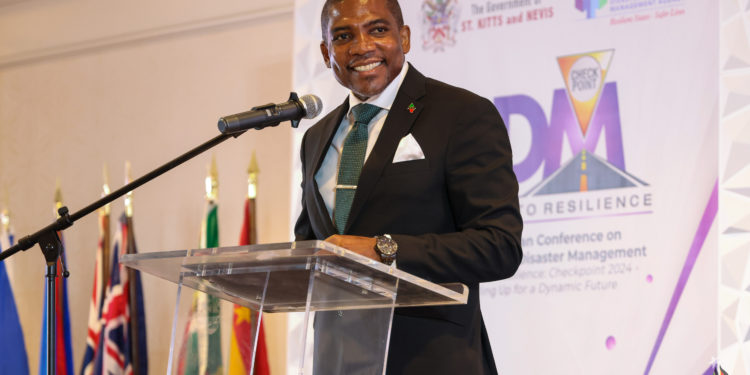Forging Ahead: Strategic Leadership and Innovation for a Resilient Caribbean
It is indeed a privilege and my distinct honour and profound responsibility on behalf of the government and the people of St. Kitts and Nevis — the host country, to welcome you, our distinguished delegates to the 13th Caribbean Conference on Comprehensive Disaster Management, convened here in the Federation of St. Kitts and Nevis.
This occasion marks a historic milestone for our twin island Federation which is currently pursuing a transformative agenda to fulfill our goals and vision of becoming a sustainable island state.
Delegates, as we gather to focus on the theme, “Road to Resilience – Checkpoint 2024: Levelling Up for a Dynamic Future.” we are compelled to reflect on the urgency and ambition with which we must confront the complex challenges facing us globally but more importantly as island nations of our region.
The Caribbean has long been synonymous with beauty, culture, and vibrancy. However, we are equally defined by and cognizant of our vulnerability to the vagaries of myriad natural disasters with which we must contend and which threaten our lives and livelihoods as small island states. Our geographic location places us at the mercy of increasingly unpredictable weather patterns, seismic activities, and the creeping threat of rising sea levels. But today, I stand before you to say this: while we may be vulnerable, we are not helpless! This conference is proof of our collective resolve to transform challenges into opportunities and vulnerabilities into strengths.
St. Kitts and Nevis, like many of our neighbors, has weathered the storms—both literally and figuratively. Hurricanes Georges, Irma, and Maria, among others, have tested our mettle. The scars of these events are etched into our history, but so too are stories of resilience, innovation, and unity. We can identify and empathize with our sister islands of Generada and St. Vincent and the Grenadines, who both bore the brunt of Beryl a few months ago. Disasters have taught us hard lessons, and those lessons have propelled us to embrace a more prepared and sustainable future.
Our response as a government has been proactive and strategic. Central to this effort is our comprehensive disaster management framework, guided by our National Disaster Plan. This framework is not just a document—it is a blueprint for safeguarding lives, protecting livelihoods, and ensuring our nation’s sustainable development. It addresses both traditional hazards such as hurricanes, earthquakes, and fires, and emerging risks like cybersecurity threats, chemical spills, and pandemics. This is the level of foresight required to confront the 21st-century challenges.
To enhance resilience across all sectors of society, we have prioritized community engagement through district systems and partnerships with NGOs. Continuous training and exercises remain the cornerstone of our preparedness efforts. At the heart of our framework lies the National Emergency Management Agency (NEMA) and its counterpart on Nevis, the Nevis Disaster Management Department (NDMD). These agencies are pillars of strength in times of crisis, ensuring coordinated responses and recovery actions.
One of our most significant achievements is the development of a modern Early Warning System (EWS). This system, aligned with the international EW4ALL framework, embodies our commitment to inclusivity and accessibility. By leveraging cutting-edge technologies and methodologies such as Geographic Information Systems (GIS) and real-time data analysis, we can forecast disasters with greater accuracy. Effective communication strategies ensure that even our most vulnerable populations are informed and empowered to act.
Our pursuit of resilience extends beyond disaster preparedness. As a government, committed to the Sustainable Island State agenda, we are integrating sustainability into every aspect of our national development. Renewable energy projects, such as the Solar Farm along the Kim Collins Highway and our geothermal energy efforts, are revolutionizing our energy landscape. These investments are designed to reduce our carbon footprint, enhance energy independence, and, crucially, increase our ability to recover quickly from disruptions.
Infrastructure also plays a pivotal role in resilience, and we are making bold investments to safeguard our built environment. From flood defenses to energy-efficient and disaster-resistant buildings, our focus is on ensuring that our physical structures are as resilient as the people they serve. This commitment is evident in projects that not only meet today’s needs but anticipate the challenges of tomorrow.
But resilience is not a solitary endeavor. The Caribbean’s interconnectedness means that no nation can stand alone in the face of disaster. Regional collaboration is not just desirable—it is essential…I would dare say, an imperative. Organizations like the Caribbean Disaster Emergency Management Agency (CDEMA) exemplify the power of unified action. Through coordinated responses, resource sharing, and training exercises, CDEMA has set a standard for regional disaster management.
St. Kitts and Nevis is proud to contribute to these efforts, but we must also strengthen them. Enhanced information-sharing platforms, joint public awareness campaigns, and the establishment of regional stockpiles are all opportunities to deepen our collaboration. Additionally, we must advocate with one voice on the global stage, demanding increased access to climate financing and technology transfers. The nations that have contributed most to climate change must bear their share of the responsibility in addressing its devastating impacts.
Distinguished delegates, leadership will be critical in shaping this future. Visionary leadership does not react to crises; it anticipates them. It is about creating an environment where innovation thrives, where communities are empowered, and where resilience is ingrained into the fabric of society. Leadership is what drives our nation’s Sustainable Island State agenda. It ensures that our policies not only address today’s challenges but lay the groundwork for a prosperous and secure future.
To my fellow leaders, let us embrace this moment to reaffirm our commitment to resilience and sustainability. Let us craft policies that prioritize the long-term well-being of our people over short-term gains. To our private sector partners, I say this: your role is indispensable. Invest in climate-smart innovations and disaster risk reduction measures. A resilient Caribbean is good for business and vital for our shared future.
To the international community, we extend a hand of partnership. Walk with us as we confront these global challenges. Provide us with the advanced technological tools and resources needed to build a more resilient Caribbean. Your support is not charity—it is an investment in a region whose success benefits the world. Moreover, it is an expression of commitment to secure successful outcomes to mitigate the effects and risks of adverse climatic conditions to whose causes they have contributed significantly.
To the people of St. Kitts and Nevis, and the wider Caribbean, know this: you are at the heart of resilience. It is your ingenuity, courage, and unity that make our region what it is. Stay informed, participate in preparedness programs, and take pride in the role you play in safeguarding our future.
As I conclude, let us remember that resilience is not merely about survival—it is about transformation. It is about creating a Caribbean that thrives despite the odds. Here in St. Kitts and Nevis, we are committed to this vision.
Let this conference be a catalyst for action, innovation, and unity. Together, we can forge a future where the Caribbean is not defined by its vulnerabilities but by its strength, leadership, and its boundless potential.
Thank you, and may this gathering inspire transformative solutions for a resilient and dynamic Caribbean.









